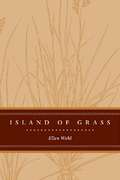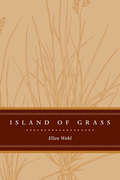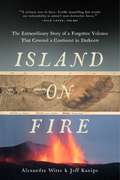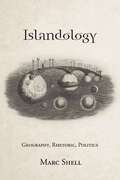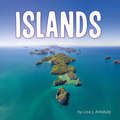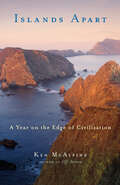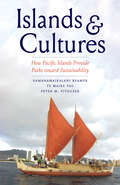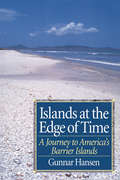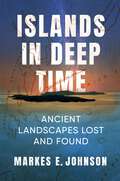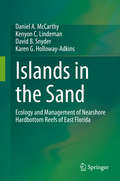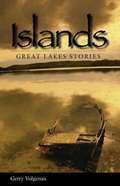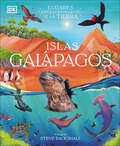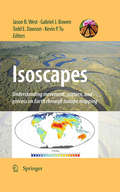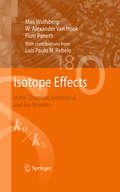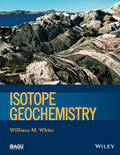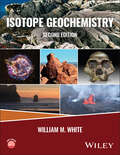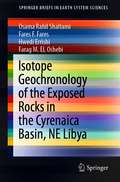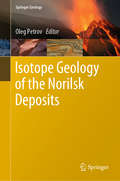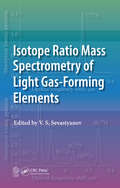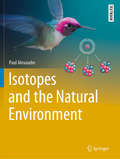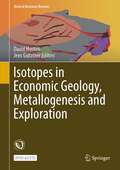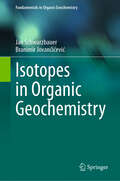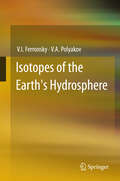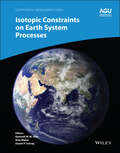- Table View
- List View
Island of Grass
by Ellen E. WohlIsland of Grass tells the story of the Cathy Fromme Prairie Natural Area, a 240-acre preserve surrounded by housing developments in Fort Collins, Colorado. This small grassland is a remnant of the once-vast prairies of the West that early European explorers and settlers described as seas of grass. Agricultural land use and urban expansion during the past two centuries have fragmented and altered these prairies. All that remains today are small islands. These remnants cannot support some of the larger animals that once roamed the prairie, but they continue to support a diverse array of plants and animals and can still teach us much about grassland ecology. Through her examinations of daily changes during walks across the Fromme Prairie over the course of a year, Ellen Wohl explores one of the more neglected ecosystems in North America, describing the geology, soils, climate, ecology, and natural history of the area, as well as providing glimpses into the lives of the plants, animals, and microbes inhabiting this landscape. Although small in size, pieces of preserved shortgrass prairie like the Cathy Fromme Prairie Natural Area are rich, diverse, and accessible natural environments deserving of awareness, appreciation, and protection. Anyone concerned with the ecology and conservation of grasslands in general, the ecology and conservation of open space in urban areas, or the natural history of Colorado will be interested in this book.
Island of Grass
by Ellen E. WohlIsland of Grass tells the story of the Cathy Fromme Prairie Natural Area, a 240-acre preserve surrounded by housing developments in Fort Collins, Colorado. This small grassland is a remnant of the once-vast prairies of the West that early European explorers and settlers described as seas of grass.Agricultural land use and urban expansion during the past two centuries have fragmented and altered these prairies. All that remains today are small islands. These remnants cannot support some of the larger animals that once roamed the prairie, but they continue to support a diverse array of plants and animals and can still teach us much about grassland ecology. Through her examinations of daily changes during walks across the Fromme Prairie over the course of a year, Ellen Wohl explores one of the more neglected ecosystems in North America, describing the geology, soils, climate, ecology, and natural history of the area, as well as providing glimpses into the lives of the plants, animals, and microbes inhabiting this landscape. Although small in size, pieces of preserved shortgrass prairie like the Cathy Fromme Prairie Natural Area are rich, diverse, and accessible natural environments deserving of awareness, appreciation, and protection. Anyone concerned with the ecology and conservation of grasslands in general, the ecology and conservation of open space in urban areas, or the natural history of Colorado will be interested in this book.
Island on Fire: The Extraordinary Story of a Forgotten Volcano That Changed the World
by Jeff Kanipe Alexandra WitzeCan a single explosion change the course of history? An eruption at the end of the 18th century led to years of climate change while igniting famine, disease, even perhaps revolution. Laki is one of Iceland's most fearsome volcanoes. Laki is Iceland's largest volcano. Its eruption in 1783 is one of history's great, untold natural disasters. Spewing out sun-blocking ash and then a poisonous fog for eight long months, the effects of the eruption lingered across the world for years. It caused the deaths of people as far away as the Nile and created catastrophic conditions throughout Europe. Island on Fire is the story not only of a single eruption but the people whose lives it changed, the dawn of modern volcanology, as well as the history--and potential--of other super-volcanoes like Laki around the world. And perhaps most pertinently, in the wake of the eruption of another Icelandic volcano, Eyjafjallajökull, which closed European air space in 2010, acclaimed science writers Witze and Kanipe look at what might transpire should Laki erupt again in our lifetime.
Islandology: Geography, Rhetoric, Politics
by Marc ShellIslandology is a fast-paced, fact-filled comparative essay in critical topography and cultural geography that cuts across different cultures and argues for a world of islands. The book explores the logical consequences of geographic place for the development of philosophy and the study of limits (Greece) and for the establishment of North Sea democracy (England and Iceland), explains the location of military hot-spots and great cities (Hormuz and Manhattan), and sheds new light on dozens of world-historical productions whose motivating islandic aspect has not heretofore been recognized (Shakespeare's Hamlet and Wagner's Ring of the Nibelung). Written by Shell in view of the melting of the world's great ice islands, Islandology shows not only new ways that we think about islands but also why and how we think by means of them.
Islands (Earth's Landforms)
by Lisa J. AmstutzAll islands are surrounded by water, but there is more to these important landforms than meets the eye! Volcanoes formed some islands. Corals formed others. Some are old while others are new. Give beginning readers all the need-to-know information about islands, including their characteristics, how they form, and where they can be found around the world.
Islands Apart: A Year on the Edge of Civilization
by Ken McalpineAuthor Ken McAlpine stands in his front yard one night in Ventura, California, trying to see the stars. His view is diminished by light pollution, making it hard to see much of anything in the sky. Our fast-paced, technologically advanced society, he concludes, is not conducive to stargazing or soul-searching. Taking a page from Thoreau's Walden, he decides to get away from the clamor of everyday life, journeying alone through California's Channel Islands National Park. There, he imagines, he might be able to "breathe slowly and think clearly, to examine how we live and what we live for."In between his week-long solo trips through these pristine islands, McAlpine reaches out to try to better understand his fellow man: he eats lunch with the homeless in Beverly Hills, sits in the desert with a 98-year-old Benedictine monk, and befriends a sidewalk celebrity impersonator in Hollywood. What he discovers about himself and the world we live in will inspire anyone who wishes they had the time to slow down and notice the wonders of nature and humanity.To learn more about the author, visit his website at www.kenmcalpine.com.
Islands and Cultures: How Pacific Islands Provide Paths toward Sustainability
by Peter M. Vitousek Kamanamaikalani Beamer Te Maire TauA uniquely collaborative analysis of human adaptation to the Polynesian islands, told through oral histories, biophysical evidence, and historical records Humans began to settle the area we know as Polynesia between 3,000 and 800 years ago, bringing with them material culture, including plants and animals, and ideas about societal organization, and then adapting to the specific biophysical features of the islands they discovered. The authors of this book analyze the formation of their human-environment systems using oral histories, biophysical evidence, and historical records, arguing that the Polynesian islands can serve as useful models for how human societies in general interact with their environments. The islands&’ clearly defined (and relatively isolated) environments, comparatively recent discovery by humans, and innovative and dynamic societies allow for insights not available when studying other cultures. Kamana Beamer, Te Maire Tau, and Peter Vitousek have collaborated with a dozen other scholars, many of them Polynesian, to show how these cultures adapted to novel environments in the past and how we can draw insights for global sustainability today.
Islands at the Edge of Time: A Journey To America's Barrier Islands
by Gunnar HansenIslands at the Edge of Time is the story of one man's captivating journey along America's barrier islands from Boca Chica, Texas, to the Outer Banks of North Carolina. Weaving in and out along the coastlines of Texas, Louisiana, Mississippi, Alabama, South Carolina, and North Carolina, poet and naturalist Gunnar Hansen perceives barrier islands not as sand but as expressions in time of the processes that make them. Along the way he treats the reader to absorbing accounts of those who call these islands home -- their lives often lived in isolation and at the extreme edges of existence -- and examines how the culture and history of these people are shaped by the physical character of their surroundings.
Islands in Deep Time: Ancient Landscapes Lost and Found
by Markes E. JohnsonHilltops surrounded by farmland in southern Wisconsin turn out to be the eroded remnants of an ancient archipelago. An island in the Yellow Sea where Korean tourists flock is the peak of a flooded mountain rising from a drowned continental shelf. From a mountaintop shrine to Genghis Khan in Inner Mongolia, the silhouette of a Silurian seascape can be spotted. On the shores of Hudson Bay, where polar bears patrol the Arctic tundra, a close look unveils what was a tropical coastline encrusted with corals nearly 450 million years ago.The geologist Markes E. Johnson invites readers on a journey through deep time to find the traces of ancient islands. He visits a dozen sites around the globe, looking above and below today’s waterlines to uncover how landscapes of the past are preserved in the present. Going back 500 million years to the Cambrian through the Pleistocene 125,000 years ago, this book reconstructs how “paleoislands” appeared under different climatic conditions and environmental constraints. Finding vestiges of prehistoric ecologies, Johnson emphasizes the complexity of island ecosystems and the importance of preserving these significant sites.Inviting and accessible, this book is a travelogue that takes readers through time as well as space. Islands in Deep Time shares the adventure of exploring striking locations across geologic eras and issues a passionate call for their conservation.
Islands in the Sand: Ecology and Management of Nearshore Hardbottom Reefs of East Florida
by Kenyon C. Lindeman David B. Snyder Daniel A. McCarthy Karen G. Holloway-AdkinsNearshore hardbottom reefs of Florida’s east coast are used by over 1100 species of fishes, invertebrates, algae, and sea turtles. These rocky reefs support reproduction, settlement, and habitat use, and are energy sources and sinks. They are also buried by beach renourishment projects in which artificial reefs are used for mitigation. This comprehensive book is for research scientists and agency personnel, yet accessible to interested laypersons including beachfront residents and water-users.An unprecedented collection of research information and often stunning color photographs are assembled including over 1250 technical citations and 127 figures. These shallow reefs are part of a mosaic of coastal shelf habitats including estuarine seagrasses and mangroves, and offshore coral reefs.These hardbottom habitats are federally designated as Essential Fish Habitats - Habitats of Particular Concern and are important feeding areas for federally-protected sea turtles. Organismal and assemblage responses to natural and man-made disturbances, including climate change, are examined in the context of new research and management opportunities for east Florida’s islands in the sand.
Islands: Great Lakes Stories
by Gerry VolgenauMost people are stunned to learn that there are some 35,000 islands in the Great Lakes, ranging from a large stone with its top above water level to the world's largest freshwater island, Manitoulin. Islands: Great Lakes' Stories focuses on 18 of these islands with their histories and personalities.
Islas Galápagos (Galapagos)
by DKTortugas gigantes, lobos marinos, fragatas, flores paradisíacas y arrecifes…Las Islas Galápagos no se conocen como Islas Encantadas porque sí. Se ganaron este nombre por su grandiosa biodiversidad de flora y fauna, que atrajo biólogos de todo el mundo desde hace siglos.Con un enfoque educativo y diseño atractivo, esta guía para niños es un recorrido ilustrado y fotográfico de la flora, fauna y geología de uno de los lugares más singulares y ricos en naturaleza del planeta.- Hermosas ilustraciones y fascinantes fotografías acompañadas de texto escrito por expertos.- Mapa de las islas y explicaciones sobre su formación, para que los niños las identifiquen fácilmente y aprendan su origen.- Información detallada de las especies (terrestres y marinas) que las habitan y de la geología del archipiélago.- También incluye una sección en la que se explican los esfuerzos por su conservación.-Con notas sobre cómo estas islas fueron fuente de inspiración para Darwin y su teoría de la evolución.Especies endémicas, animales increíbles, clima, evolución, migración y mucho más. Descúbrelo todo de este lugar único en nuestra planeta y de su visitante más famoso: Charles Darwin. Un libro perfecto para que los niños aprendan sobre geología y biología junto a padres y profesores.
Isolated Objects in Quadratic Gravity: From Action Principles to Observations (Springer Theses)
by Samuele SilvervalleOne of the main unanswered question of modern Physics is "How does gravity behave at small scales?". The aim of this thesis is to illustrate in a comprehensive but accessible way how to look for deviations from Einstein's theory of General Relativity in this regime, looking at the simplest celestial bodies: static and spherically symmetric ones.With a conservative and bottom-up approach, at smaller scales the first corrections to the action of General Relativity are generally considered to be terms quadratic in the curvature tensors; while these modifications do not cure the inconsistency between gravity and quantum mechanics, the solutions of this theory are plausible candidates to be the first-order corrections of the classical ones.Even with such simple modifications, a striking picture emerges from the study of isolated objects: the unique Schwarzschild solution of General Relativity is only a rare bird in the set of solutions, with non-Schwarzschild black holes, wormholes and naked singularities appearing as possible substitutes.Tailored to graduate students and researchers entering this field, this thesis shows how to construct these new solutions from action principles, how to characterize their metric, how to study their physical properties, such as their stability or Thermodynamics, and how to look for phenomenological signatures.
Isoscapes
by Todd E. Dawson Gabriel J. Bowen Jason B. West Kevin P. TuStable isotope ratio variation in natural systems reflects the dynamics of Earth systems processes and imparts isotope labels to Earth materials. Carbon isotope ratios of atmospheric CO2 record exchange of carbon between the biosphere and the atmosphere; the incredible journeys of migrating monarchs is documented by hydrogen isotopes in their wings; and water carries an isotopic record of its source and history as it traverses the atmosphere and land surface. Through these and many other examples, improved understanding of spatio-temporal isotopic variation in Earth systems is leading to innovative new approaches to scientific problem-solving. This volume provides a comprehensive overview of the theory, methods, and applications that are enabling new disciplinary and cross-disciplinary advances through the study of "isoscapes": isotopic landscapes. "This impressive new volume shows scientists deciphering and using the natural isotope landscapes that subtly adorn our spaceship Earth.", Brian Fry, Coastal Ecology Institute, Louisiana State University, USA "An excellent timely must read and must-have reference book for anybody interested or engaged in applying stable isotope signatures to questions in e.g. Anthropology, Biogeochemistry, Ecology, or Forensic Science regarding chronological and spatial movement, changes, or distribution relating to animals, humans, plants, or water.", Wolfram Meier-Augenstein, Centre for Anatomy & Human Identification, University of Dundee, UK "Natural resources are being affected by global change, but exactly where, how, and at what pace? Isoscapes provide new and remarkably precise answers.", John Hayes, Woods Hole Oceanographic Institution, USA "This exciting volume is shaping a new landscape in environmental sciences that is utilizing the remarkable advances in isotope research to enhance and extend the capabilities of the field.", Dan Yakir, Weizmann Institute of Science, Israel
Isotope Effects
by Luís Paulo Rebelo W. Alexander Van Hook Max Wolfsberg Piotr PanethAs the title suggests, Isotope Effects in the Chemical, Geological and Bio Sciences deals with differences in the properties of isotopically substituted molecules, such as differences in the chemical and physical properties of water and the heavy waters. Since the various fields in which isotope effects are applied do not only share fundamental principles but also experimental techniques, this book includes a discussion of experimental apparatus and experimental techniques. Isotope Effects in the Chemical, Geological and Bio Sciences is an educational monograph addressed to graduate students and others undertaking isotope effect research. The fundamental principles needed to understand isotope effects are presented in appropriate detail. While it is true that these principles are more familiar to students of physical chemistry and some background in physical chemistry is recommended, the text provides enough detail to make the book an asset to students in organic and biochemistry, and geochemistry.
Isotope Geochemistry (Wiley Works)
by William M. WhiteThis book provides a comprehensive introduction to radiogenic and stable isotope geochemistry. Beginning with a brief overview of nuclear physics and nuclear origins, it then reviews radioactive decay schemes and their use in geochronology. A following chapter covers the closely related techniques such as fission-track and carbon-14 dating. Subsequent chapters cover nucleosynthetic anomalies in meteorites and early solar system chronology and the use of radiogenic isotopes in understanding the evolution of the Earth’s mantle, crust, and oceans. Attention then turns to stable isotopes and after reviewing the basic principles involved, the book explores their use in topics as diverse as mantle evolution, archeology and paleontology, ore formation, and, particularly, paleoclimatology. A following chapter explores recent developments including unconventional stable isotopes, mass-independent fractionation, and isotopic ‘clumping’. The final chapter reviews the isotopic variation in the noble gases, which result from both radioactive decay and chemical fractionations.
Isotope Geochemistry (Wiley Works)
by William M. WhiteISOTOPE GEOCHEMISTRY Provides a thorough and up-to-date overview of radiogenic and stable isotope geochemistry Now in its second edition, Isotope Geochemistry presents a comprehensive introduction to radiogenic and stable isotope geochemistry. The first five chapters cover fundamentals including the physics of nuclei, radioactive decay, nucleosynthesis, geochronology, and the theory of stable isotope fractionation. The next chapter focuses on the isotope geochemistry of meteorites and their constraints on the formation of the solar system and the Earth. The subsequent three chapters cover radiogenic and stable isotope geochemistry evolution of the Earth’s mantle and crust. Three more chapters are devoted to the Earth’s surface, the exogene, including the hydrologic system, the biosphere, and climate. A new chapter in this edition focuses on the use of isotopes in paleontology and archeology. The final chapter is devoted to the isotope geochemistry of the noble gases. Illustrated in full color throughout, Isotope Geochemistry is intended primarily as a textbook for advanced undergraduate and graduate students. It is also intended as a reference for earth science professionals, reflecting the impact that isotope geochemistry has on virtually every aspect of the earth sciences, from climate change and geomorphology to geodynamics.
Isotope Geochronology of the Exposed Rocks in the Cyrenaica Basin, NE Libya (SpringerBriefs in Earth System Sciences)
by Osama Rahil Shaltami Fares F. Fares Hwedi Errishi Farag M. EL OshebiThis book provides a detailed explanation of the exposed rocks in the Cyrenaica Basin, NE Libya. The authors integrate isotope stratigraphy for building a high-resolution age for the exposed rocks of the basin.
Isotope Geology of the Norilsk Deposits (Springer Geology)
by Oleg PetrovThe book presents isotope-geochemical investigations of the world’s largest reserves of copper, nickel, and platinum-group elements in the Norilsk ore region. Ever since its discovery, generations of geologists have been fascinated by the geology of these deposits, described as a 250 Ma magmatic formation with mafic and ultramafic layered intrusions, disseminated ore and continuous copper-nickel ore bed. The book includes the results of more than 5,000 analyses of eleven isotopic systems, performed at the Russian Research Geological Institute’s Center of Isotopic Research between 2005 and 2014. The book is intended for specialists in isotope geology, metallogeny, ore geology and students of geology.
Isotope Ratio Mass Spectrometry of Light Gas-Forming Elements
by V. S. SevastyanovIsotope Ratio Mass Spectrometry of Light Gas-Forming Elements explores different methods of isotope analysis, including spark, secondary ion, laser, glow discharge, and isotope ratio mass spectrometry. It explains how to evaluate the isotopic composition of light elements (H, C, N, O) in solid, liquid, and gaseous samples of organic and inorganic s
Isotopes and the Natural Environment (Springer Textbooks in Earth Sciences, Geography and Environment)
by Paul AlexandreThis book provides straightforward and practical information on isotopes applied to a variety of natural sciences. It covers the basics of isotopes and includes detailed examples from a range of natural sciences: ecology, biology, human health, environment and climate, geography, and geology, highlighting their applicability in these fields. It is a must-read for all advanced-undergraduate and graduate students working with isotopes, regardless of the area, and is a very useful one-stop resource for scientists starting in isotope research.
Isotopes in Economic Geology, Metallogenesis and Exploration (Mineral Resource Reviews)
by Jens Gutzmer David HustonThis open access book documents the use of radiogenic and stable isotopes to study mineral deposits from a global to the deposit scale. It includes data-sets that have been directly used in mineral exploration. Isotopic data have been key to developing models for the origin of many mineral deposit types. The book has four sections: (1) the use of radiogenic isotopes to date mineral deposits, (2) the use of radiogenic isotope mapping to understand metal sources and regional- to district-scale controls on metallogenesis, (3) the use of light stable isotopes to determine fluid and sulfur sources, and (4) the use of metallic stable isotopes to understand the sources of ore metals. Each section includes chapters on specific isotopic systems and/or mineral systems that provide information on theory, analytical methods, uses in deposit and metallogenic studies, examples, and traps for young players.
Isotopes in Organic Geochemistry (Fundamentals in Organic Geochemistry)
by Jan Schwarzbauer Branimir JovančićevićThis volume of the series Fundamentals of Organic Geochemistry provides an overview of isotope analysis in organic geochemistry and related fields of applied sciences. It dives deep into the basics of isotopes and isotopic fractioning processes with applications e.g. in environmental biodegradation or correlations of fossil matter. This textbook helps students understanding the geoscientific, analytical, and chemical isotope aspects in complex natural systems. Students learn the importance of isotope organic geochemistry and its relationship to fundamental processes in the geosphere and biosphere, which include e.g. photosynthesis, evaporation/precipitation within the global water cycle, biotic degradation, and biosynthesis. The book is intended for chemistry and geoscience students at BSc, MSc, and PhD levels.
Isotopes of the Earth's Hydrosphere
by V. I. Ferronsky V. A. PolyakovThis book covers the distribution, hydrochemistry and geophysics of the naturally occurring stable isotopes namely: hydrogen, oxygen and radioactive tritium, carbon and other cosmogenic and radiogenic isotopes of the uranium-thorium series, in the oceans and in atmosphere, the earth's surface and ground water. The use of environmental isotopes in the three main areas of natural waters is discussed: origin, dynamics and residence time in natural reservoirs. The origin of the hydrosphere is examined in the light of isotopic, new cosmochemical and recent theoretical results. The book will be of interest to scientists and researchers who use environmental isotopes in solving scientific and practical problems in hydrology, hydrogeology, oceanography, meteorology, hydrogeochemistry and cosmochemistry. Lecturers, students and postgraduates in these fields will also find it useful.
Isotopic Constraints on Earth System Processes (Geophysical Monograph Series)
by Daniel P. Schrag Kenneth W. W. Sims Kate MaherIsotopic Constraints on Earth System Processes Isotopic Constraints on Earth System Processes From establishing the absolute age of the Earth to providing a stronger understanding of the nexus between geology and life, the careful measurement and quantitative interpretation of minor variations in the isotopic composition of Earth’s materials has provided profound insight into the origins and workings of our planet. Isotopic Constraints on Earth System Processes presents examples of the application of numerous different isotope systems to address a wide range of topical problems in Earth system science. Volume highlights include: examination of the natural fractionation of non-traditional stable isotopes utilizing isotopes to understand the origin of magmas and evolution of volcanic systems application of isotopes to interrogate and understand Earth’s Carbon and Oxygen cycles examination of the geochemical and hydrologic processes that lead to isotopic fractionation application of isotopic reactive transport models to decipher hydrologic and biogeochemical processes The American Geophysical Union promotes discovery in Earth and space science for the benefit of humanity. Its publications disseminate scientific knowledge and provide resources for researchers, students, and professionals.
